17 charts to consider as stocks rally and the economy cools 📉📊📈
Plus a charted review of the macro crosscurrents 🔀
📈The stock market rallied to all-time highs, with the S&P 500 setting an intraday high of 6,600.21 on Friday and a closing high of 6,587.47 on Thursday. The index is now up 11.9% year-to-date. For more on the market, read: The stock market and the economy are diverging 📊
-
The stock market set new highs last week as measures of the economy, like job creation, continued to cool.
Some charts from September’s research notes, news articles, and blogs caught my eye. Instead of publishing a series of newsletters, I figured I’d do a lightning round here.
The stock market is not the economy 🙅🏻
The U.S. stock market and the U.S. economy are closely intertwined. Yet the makeup of earnings per share (EPS), which drives stock prices, differs in several key ways from the makeup of GDP.
From Wells Fargo’s Ohsung Kwon: “Although EPS has been decently correlated to GDP (52% correlation since 1948), there is a key difference in the composition of S&P 500 EPS and GDP. The U.S. economy is predominantly services-oriented, representing over 70% of GDP, but S&P 500 earnings are almost evenly split between services and goods/manufacturing.“
For more on how the stock market and the economy differ, read: The stock market and the economy are diverging 📊
The U.S. stock market is massive 💪
The world’s stock markets are often ranked based on performance. So, it can be easy to forget that the U.S. stock market eclipses the rest of the world.

It’s worth mentioning that the S&P 500 accounts for 80% of the value of all U.S. stocks. So, the S&P is effectively the U.S. stock market.
For more on the U.S. stock market and the global stage, read: Where in the world do S&P 500 companies do business? 🗺️
U.S. earnings growth prospects are strong relative to the world 🌏
One of the main reasons the U.S. stock market has grown so large is that U.S. companies have exhibited the best earnings growth for years. Some analysts expect this trend to continue.
From Morgan Stanley’s Katy Huberty: “U.S. Earnings Trends Continue to Lead Global Markets … Although YTD returns for U.S. stocks have lagged globally, U.S. stocks’ returns have been driven mostly by earnings growth, whereas earnings in Europe have been basically flat — European equities’ performance has been driven by multiple expansion and dividends. Looking forward, while earnings revisions breadth has turned up for all regions, the U.S. revisions uptrend is by far the strongest.“
For more on the outlook for U.S. stocks in the global market, read: Why I'm not losing sleep as the U.S. stock market underperforms the rest of the world 🌎
S&P 500 earnings usually go up 📈
The U.S. stock market has been going up for a very long time. Why?
Because earnings have been going up for a very long time, and earnings are the most important driver of stock prices.
Just take a look at this 90-year chart of S&P 500 earnings per share from Deutsche Bank’s Binky Chadha:
It’s worth mentioning that the earnings growth prospects for the large-cap companies in the S&P 500 are more favorable than those of small- and mid-cap companies.
For more, read: A very long-term chart of U.S. stock prices usually going up 📈 and Earnings are the most important driver of stock prices💰
A lot of companies are breaking up 💔
Here’s Sherwood News’ Hyunsoo Rim: “Amid shareholders’ growing push for simplification, spinoffs have been growing in the US. As of early September, there have been 11 announced spin-offs from S&P 500 companies — the most since 2016.“
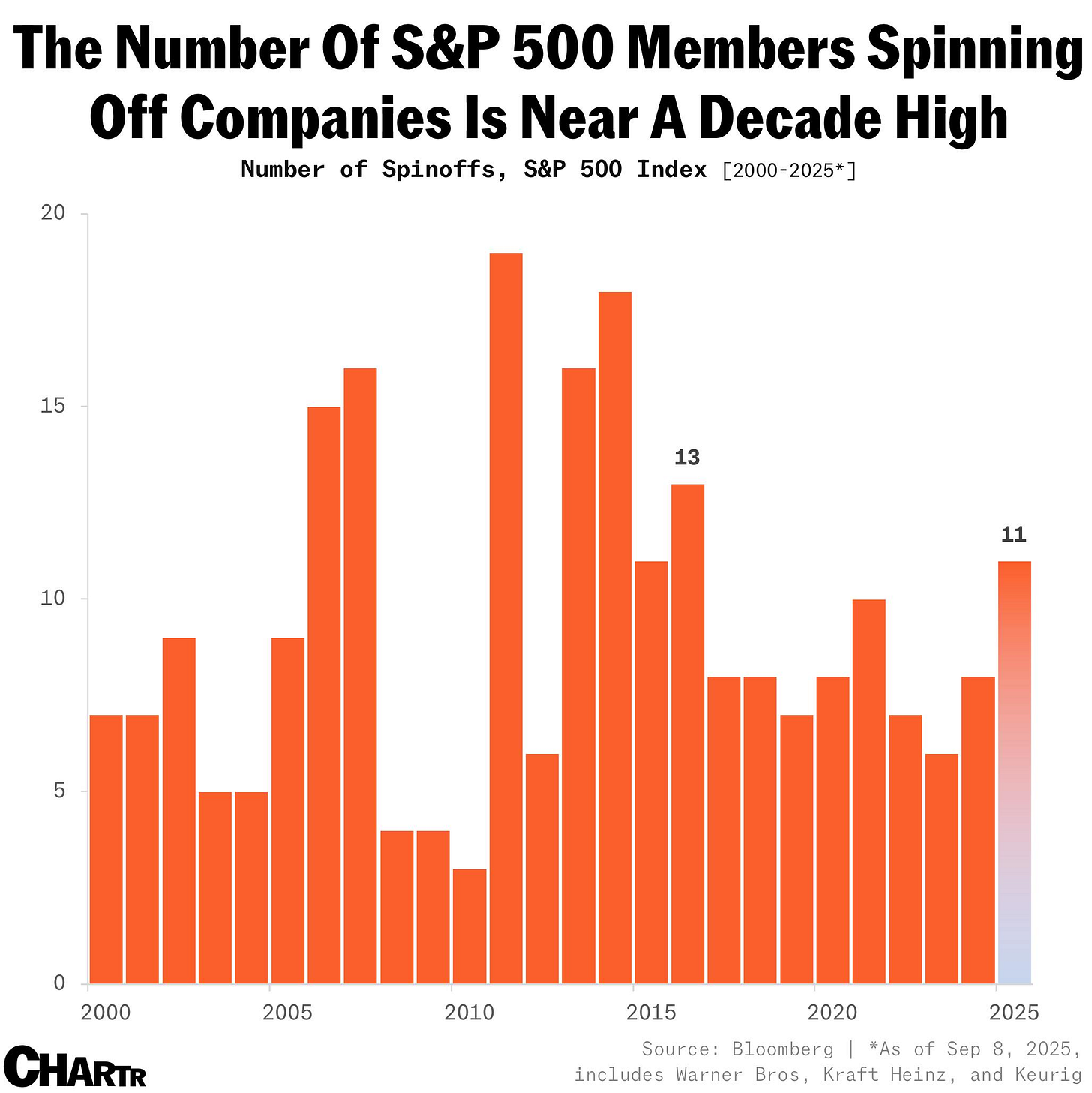
Stock price performance following a spin-off is mixed. From Rim: “But whether these corporate divorces actually pay off is another story. In the first 18-24 months following the split, companies spun off do tend to outperform the S&P 500 by ~10%, according to Trivariate Research — but those early gains might not hold up over longer horizons. … Since its 2015 launch, the S&P US Spin-Off Index — which tracks $1 billion+ S&P 500 companies spun off in the last four years — has lagged behind the main S&P 500 Index.“
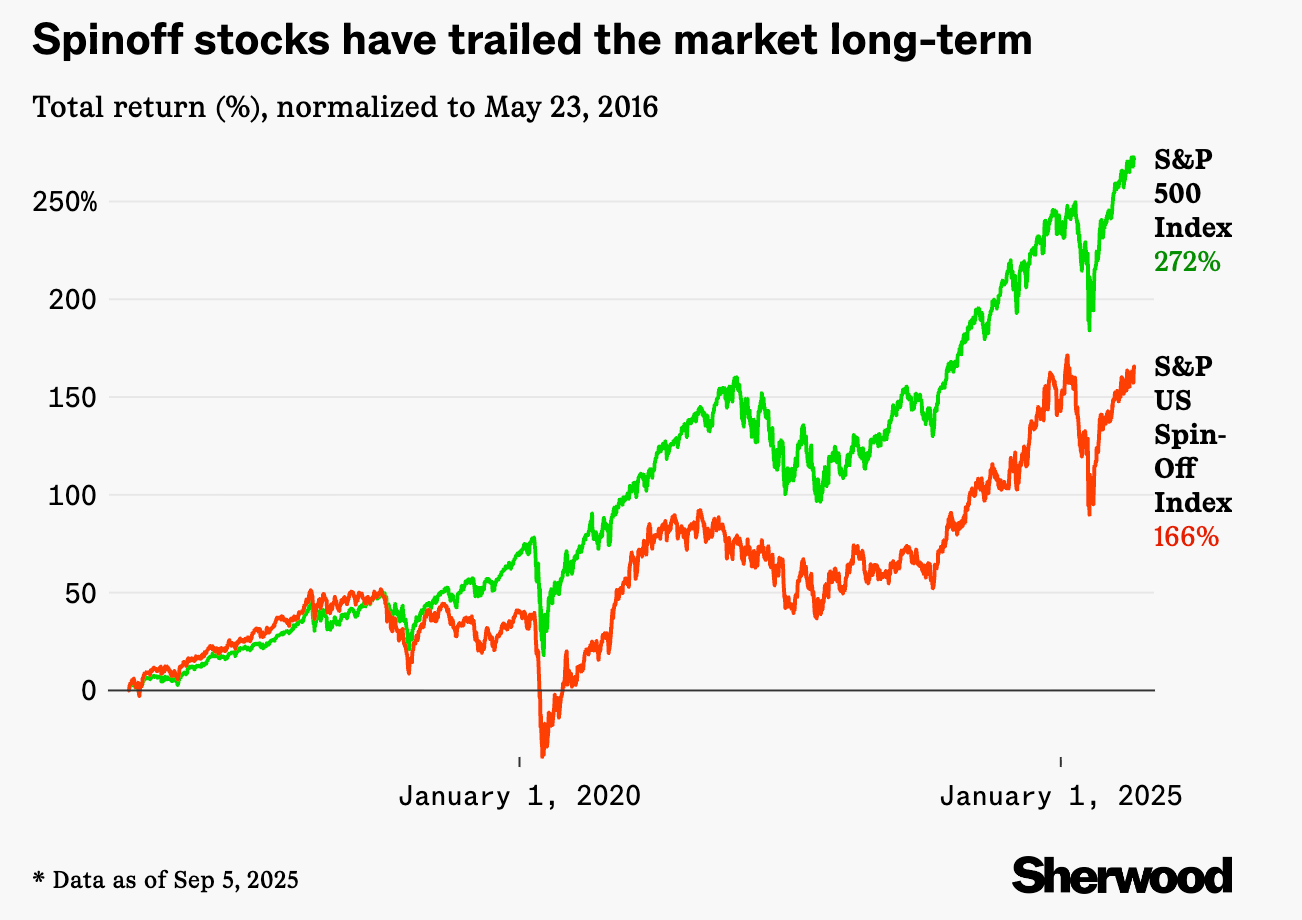
For more on the M&A side of things, read: How the S&P 500 quietly becomes bigger than 500 companies 🤝
Companies are waiting longer before going public 👴🏼
From Apollo’s Torsten Slok: “There are fewer public companies to invest in, and firms that decide to do an IPO are getting older and older. In 1999, the median age of IPOs was five years. In 2022, it was eight years, and today, the median age of IPOs has increased to 14 years. ... The rise in the age of companies going public is not only a result of the Fed raising interest rates in 2022, but also the consequence of more companies wanting to stay private for longer to avoid the burdens of being public.“
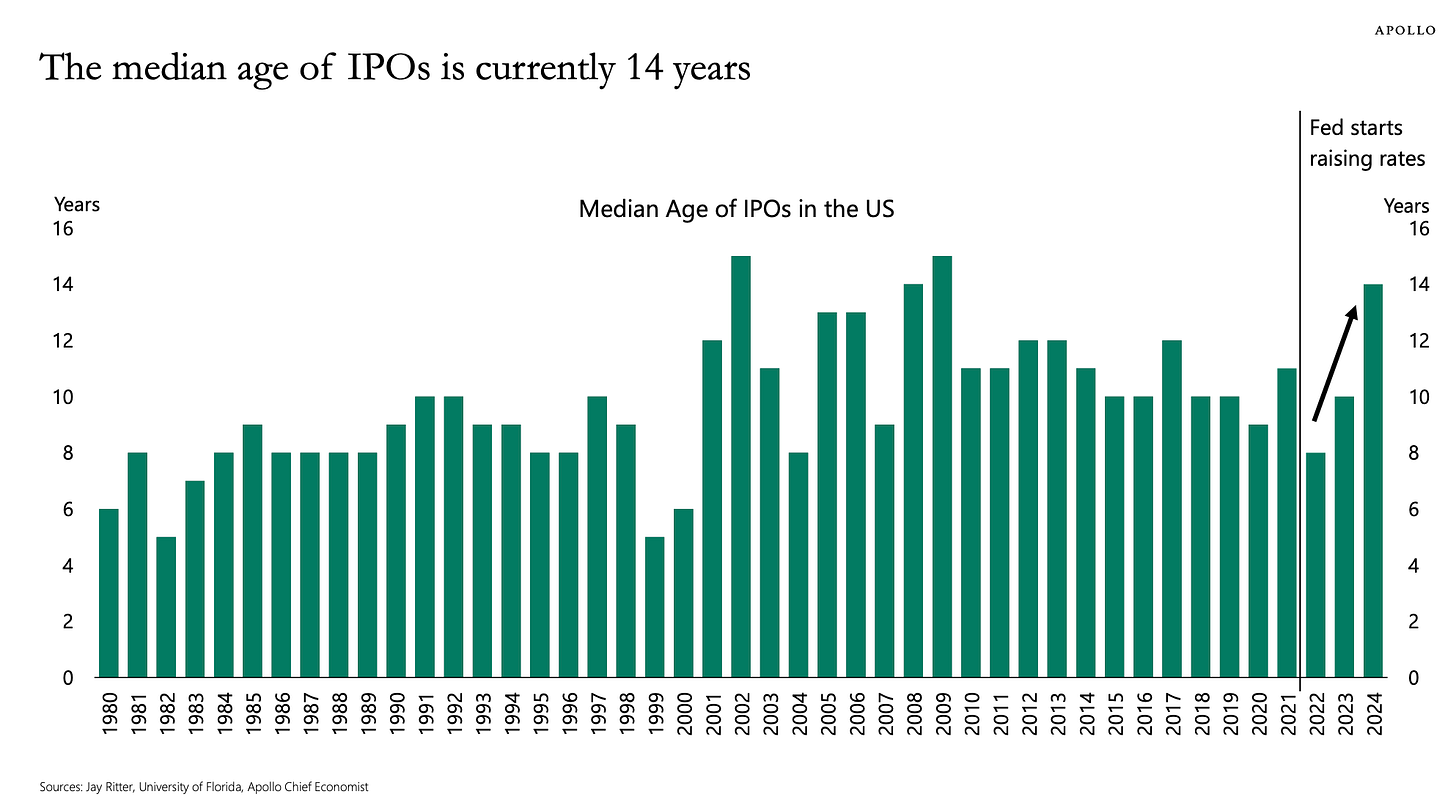
Continuing on Slok’s discussion of scarcity in publicly traded companies, S&P 500 companies continue to buy back far more shares than they issue.
But the pace of net buybacks has lagged the performance of the stock market. This trend is reflected by the declining net buyback yield.
For more discussion on buybacks, read: The truth about the hundreds of billions of dollars worth of stock buybacks 💸
Margin debt is up… but not really 🤔
Debt balances in margin accounts climbed above $1 trillion in June, setting off alarms for some.
Margin debt is a great example of a variable that needs a little more context. Ritholtz Wealth Management’s Matt Cerminaro charted margin debt as a percentage of S&P 500 market cap. He found that margin debt is arguably very low.
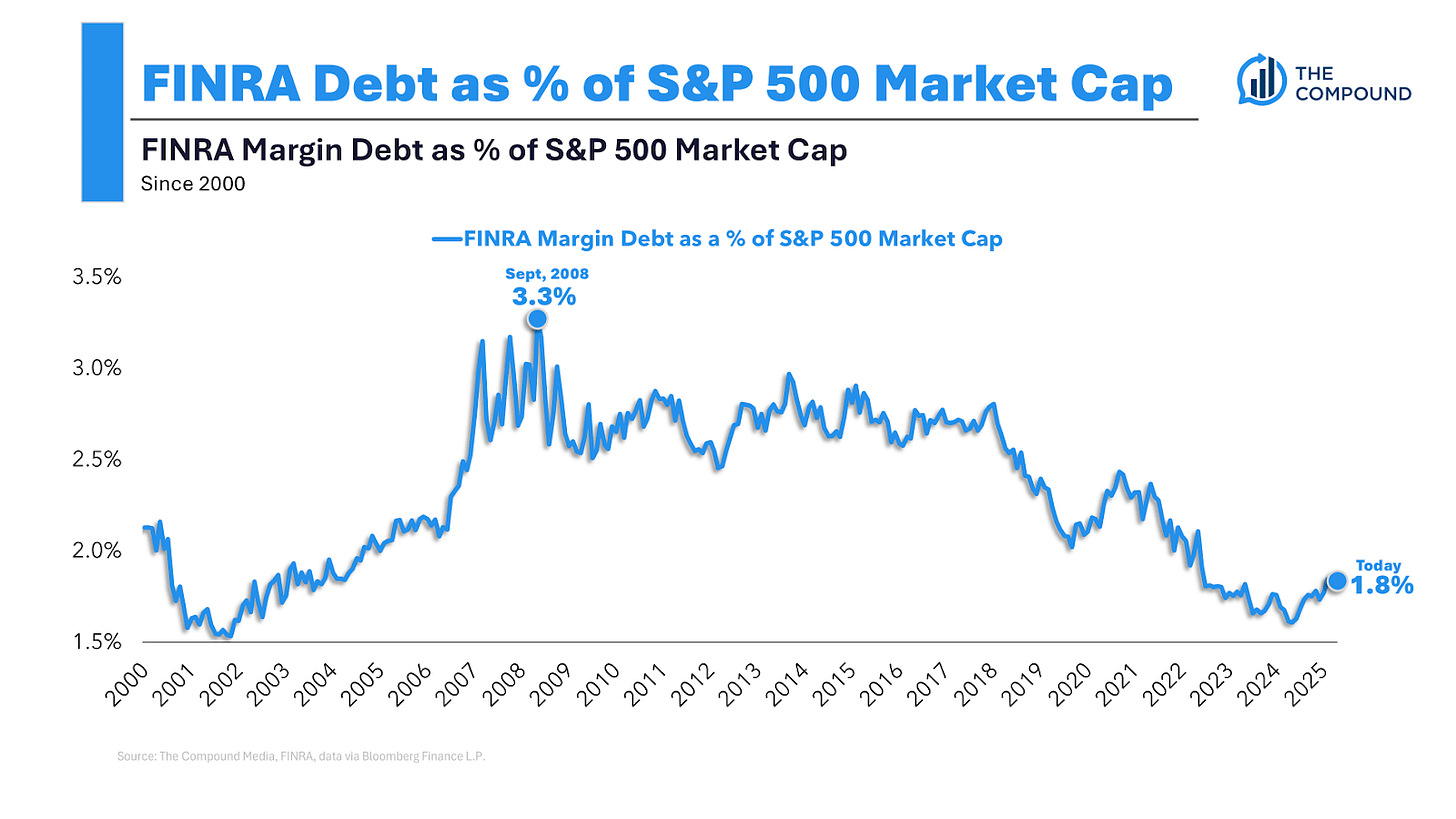
Ritholtz Wealth’s Callie Cox offered more color: “Also, investors don’t really borrow money from brokerages anymore. That’s very early 2000s, like low-rise jeans and tracksuits (although both are coming back in style, so…). They employ the same trades, but through more sophisticated products like options or leveraged exchange-traded funds (you know, those wild 3x short Tesla funds you hear about). Everyday investors haven’t had access to these tools for very long, and they’ve really leaned into non-margin leveraged trades since the early COVID days. A lot of speculation is happening outside of what margin debt is showing.“
For more on margin debt, read: Remember when people were worried about margin debt? 😬
Tariff chatter is on the rise — get ready for tariff-related inflation 🎈
Morgan Stanley analysts reviewed Q2 earnings announcements and calls to look for discussion on how companies plan to address tariffs.
From the report (emphasis added): “Unsurprisingly, we saw a significant increase in the number of mentions of tariff mitigation strategies last quarter with many companies citing multiple strategies. … Pricing power overtook supply chain diversification as the most frequently mentioned mitigation strategy. Across all industries, mentions of supply chain diversification relative to other mitigation strategies appear to be declining, which in our view reflects the notion that supply chain diversification is costly, time-consuming, and a longer-term solution.“
For more on how companies are addressing tariffs, read: Wall Street's view on tariffs summed up in two lengthy sentences 📝 and Companies plan to 'pass on costs' to customers 🤑
Big rallies are followed by further gains 🚀
The stock market has been on a tear since April. Are we due for a pullback?
From Carson Group’s Ryan Detrick: “The S&P 500 just completed one of the best five month rallies ever, up more than 30%. Since 1950, this only happened five other times, but the returns going out a year were much better than average. A year later? Never lower and up more than 18% on average.“
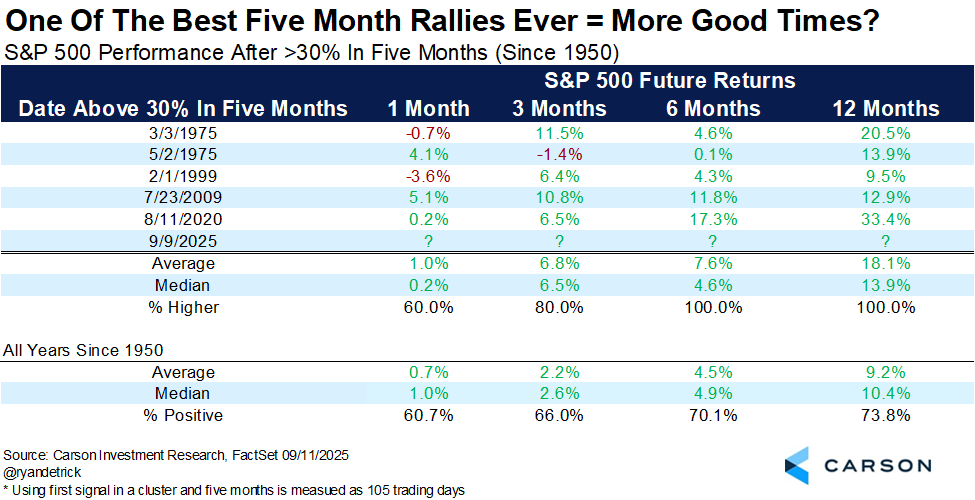
This is consistent with what we know about all-time highs being a great time to buy.
From Capital Economics’ James Reilly: “It can be tempting to think the risks must be skewed to the downside. But 12-month inflation-adjusted returns since 1964 have been slightly stronger following new all-time highs compared to the average day. The frequency of significant losses has also been lower after reaching all-time highs, while the distribution of 12-month real returns is similar in both samples.”
If you’re interested in my experience with all-time highs, read: Checking in on the unluckiest market timer I know 🍀
About Fed rate cuts and stocks ⚖️
The Federal Reserve is expected to announce a rate cut at the conclusion of its monetary policy meeting on Wednesday. This would be a resumption in cuts, which have been on pause since last December.
What would a cut mean for stocks?
It’s not that simple. Here’s BMO’s Brian Belski (emphasis added): “We identified ten such cycles going back to 1982 when the Fed started officially announcing its policy actions. According to our analysis, the S&P 500 delivered positive returns in the 12 months following such rate cuts for eight of the ten cycles with an average gain of 10.4%. However, the macro context behind the moves mattered a great deal, which is why performance varied so significantly around these turning points ranging from -23.9% to 32.1%. In cycles where rate cuts were able to prolong economic expansion and keep corporate earnings on an upward trend, stocks performed quite well. However, in cycles where monetary stimulus was unable to prevent an economic downturn (i.e., 2001 and 2007), stocks recorded significant losses in the following year as earnings growth struggled.“
Yes, the Fed can have an impact on economic activity. But what ultimately matters for markets is where the economy and corporate earnings head. We’ve discussed this repeatedly at length. (If you’re catching up, read: 'How many times will the Fed cut rates?' is not the right question for stock market investors 🔪 or There's a more important force than the Fed driving the stock market 💪)
A rate cut isn’t guaranteed to stimulate growth. In fact, JP Morgan’s David Kelly recently warned that rate cuts “could weaken rather than strengthen demand.”
-
For more roundups of charts:
15 charts to consider with the stock market at record highs 📊📈
8 chaotic scatterplots — and the bullish quality they all share 🐞
22 eye-catching charts as we consider what's next for the stock market 📈
Review of the macro crosscurrents 🔀
There were several notable data points and macroeconomic developments since our last review:
👎 Consumer price inflation ticks higher. The Consumer Price Index (CPI) in August was up 2.9% from a year ago, up from last month’s rate of 2.7%. Adjusted for food and energy prices, core CPI was up 3.1%, flat from the prior month’s rate.
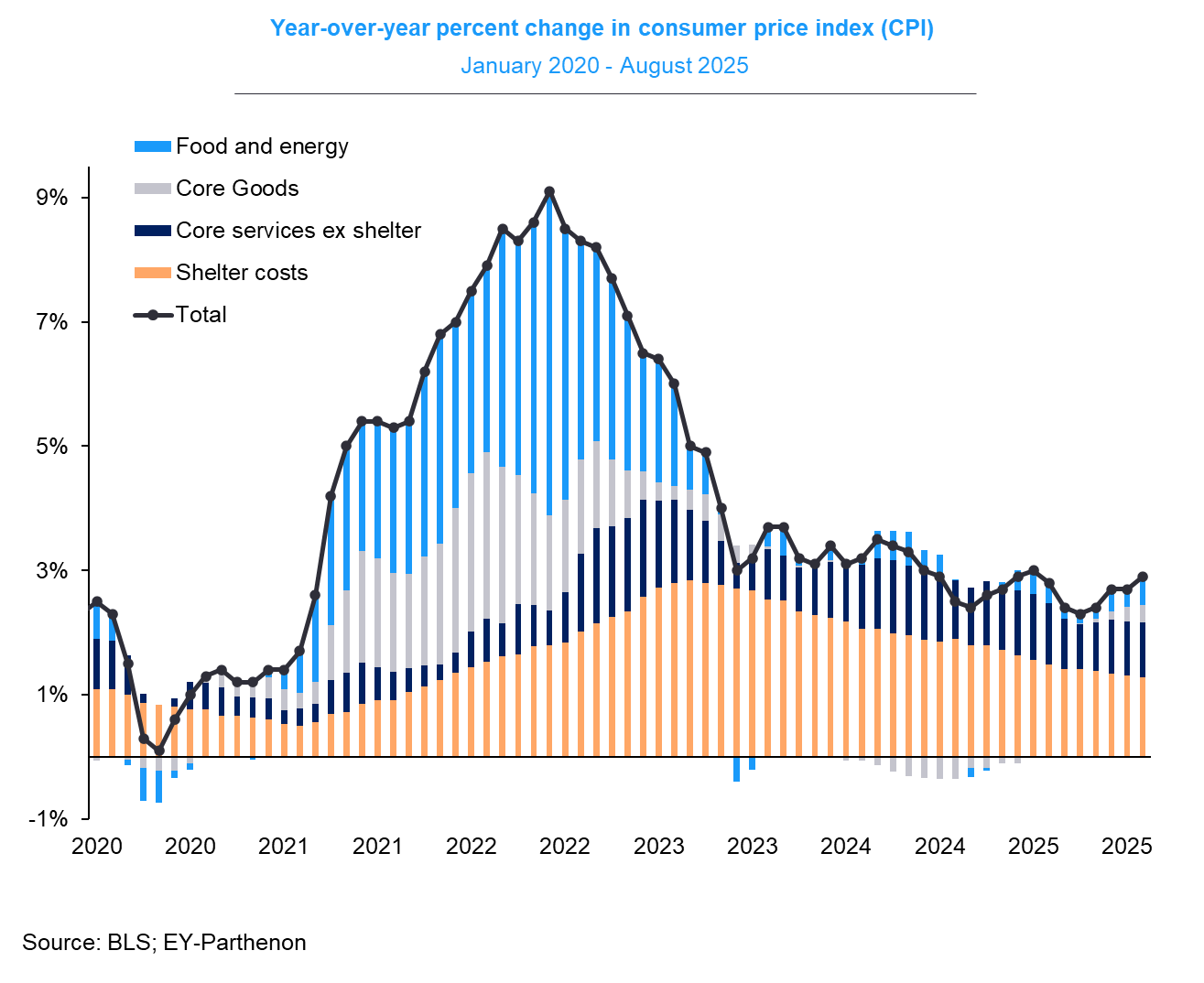
On a month-over-month basis, CPI was up 0.4% and core CPI increased 0.3%. If you annualize the three-month trend in the monthly figures — a reflection of the short-term trend in prices — core CPI climbed 3.6%.
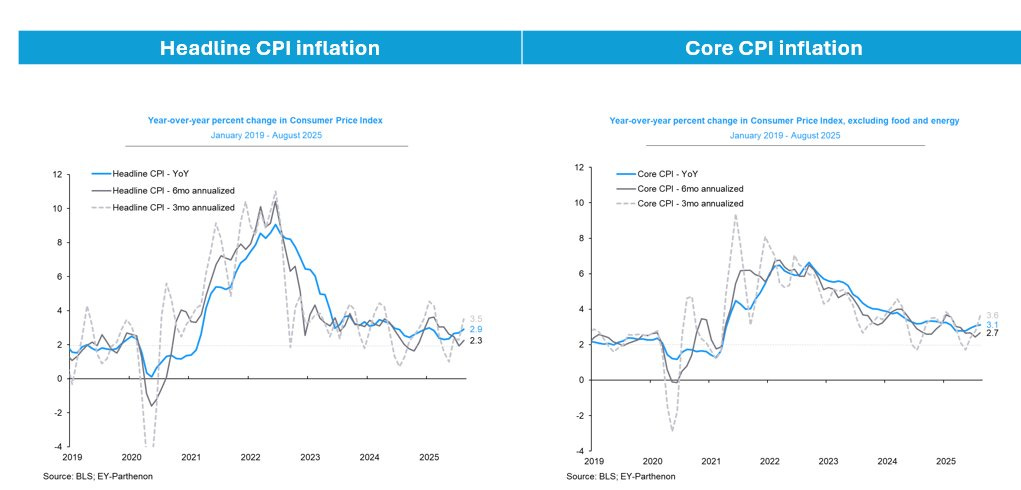
For more on inflation and how it’s affected by tariffs, read: Companies plan to 'pass on costs' to customers 🤑
👍 Wholesaler price inflation falls. The Producer Price Index (PPI) in August was up 2.6% from a year ago. Adjusted for food and energy prices, core PPI was up 2.8%, up from the prior month’s 2.7% rate.
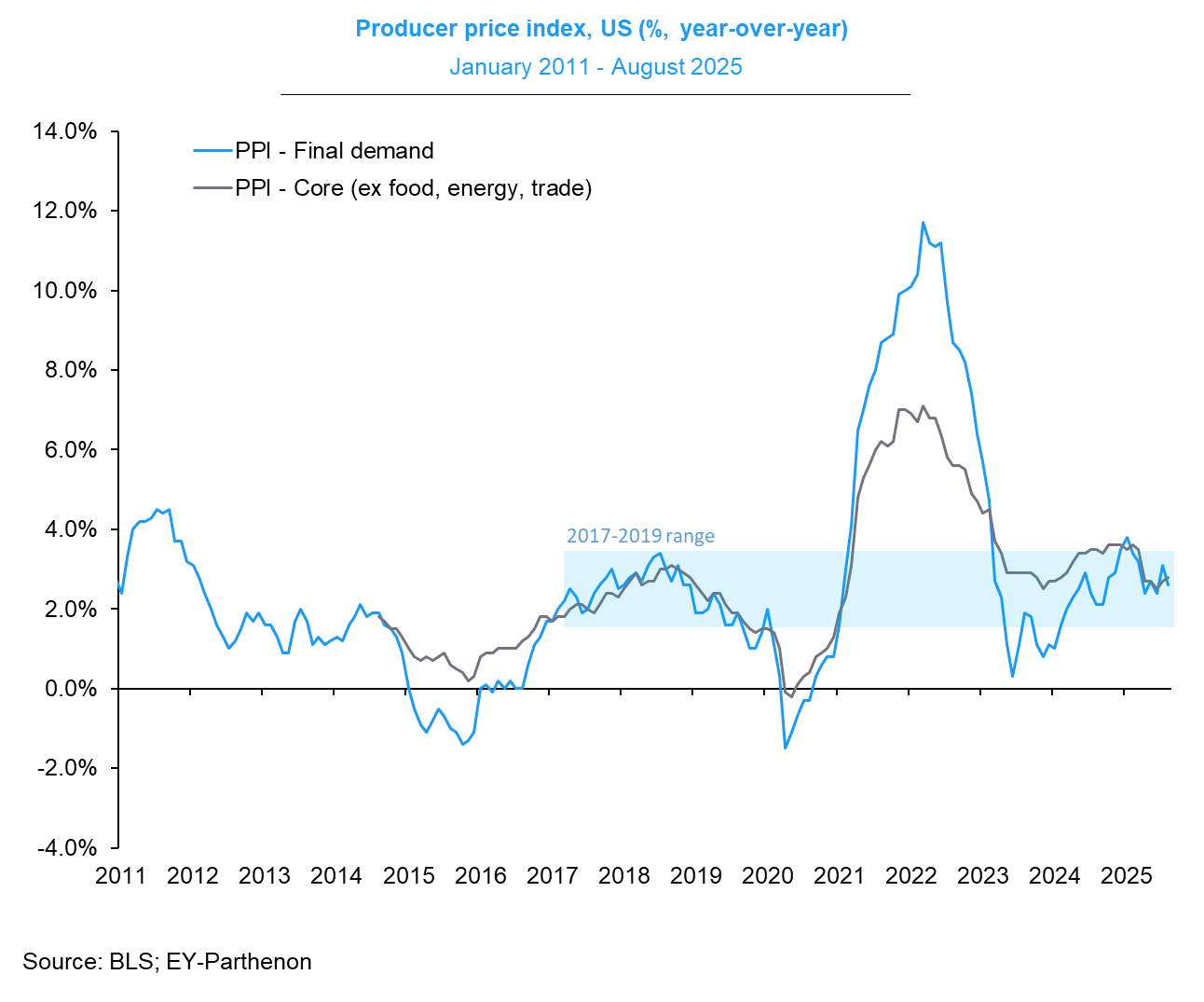
On a month-over-month basis, PPI declined 0.1% and core PPI rose 0.3%.
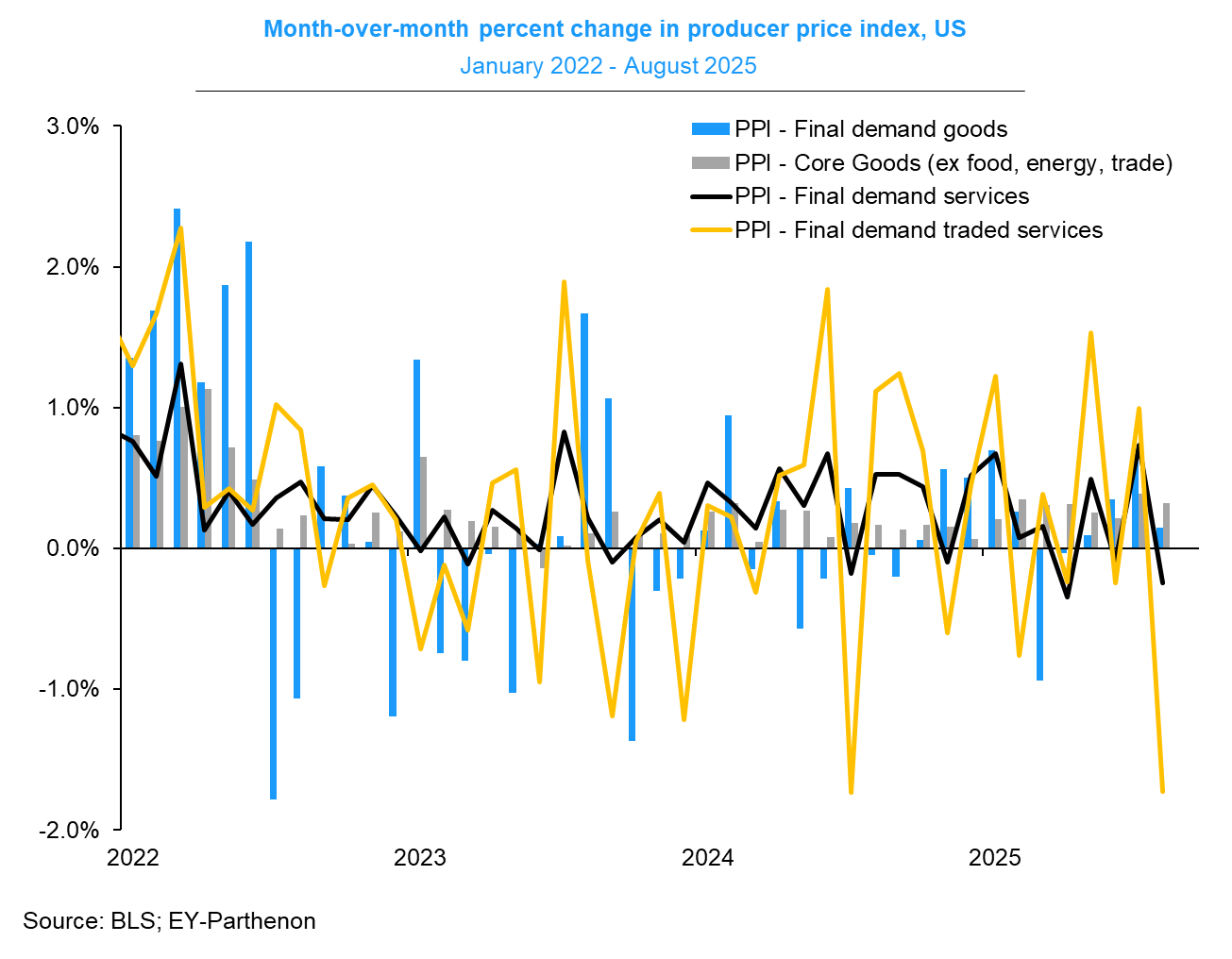
⛽️ Gas prices tick lower. From AAA: “As drivers settle into their fall routines, gas demand is going down, and eventually, pump prices should follow suit. The national average for a gallon of regular is down about a penny to $3.19. There remains an abundance of crude oil supply which is outweighing demand. The seasonal transition to winter-blend gasoline – which is cheaper to produce – is also beginning. While the national average has been relatively stable, drivers in the Pacific Northwest are feeling pain at the pump. Gas prices in the area have jumped more than 20 cents in the past week due to the shutdown of a major pipeline that transports fuel from Washington to Oregon. The pipeline is reportedly expected to resume operations in a few days.”
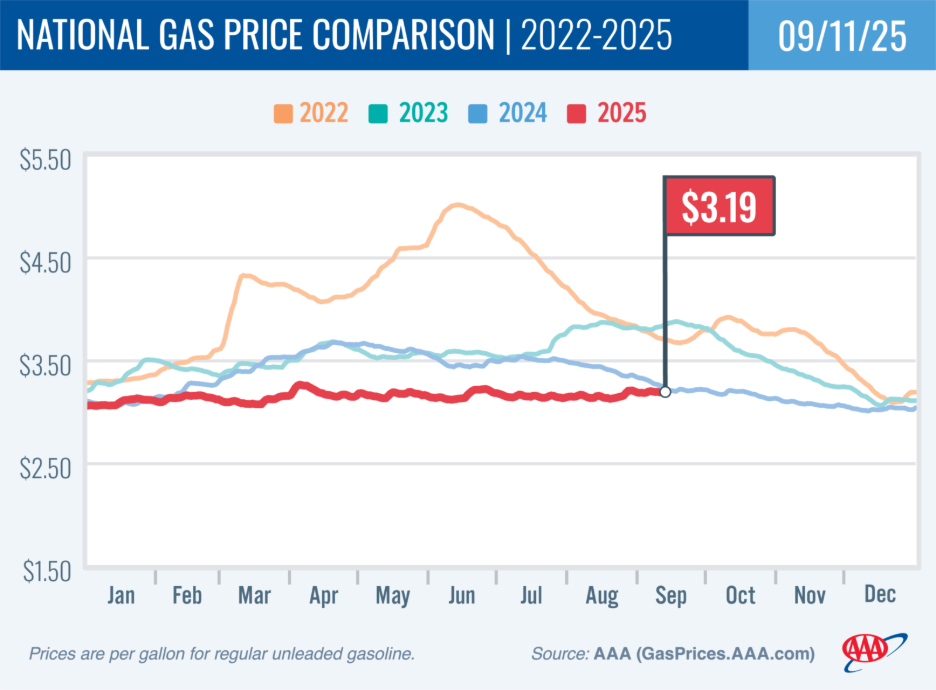
For more on energy prices, read: Higher oil prices meant something different in the past 🛢️
👎 Inflation expectations heat up. From the New York Fed’s August Survey of Consumer Expectations: “Median inflation expectations ticked up by 0.1 percentage point to 3.2% at the one-year-ahead horizon in August. They were unchanged at the three-year- (3.0%) and five-year-ahead (2.9%) horizons.”
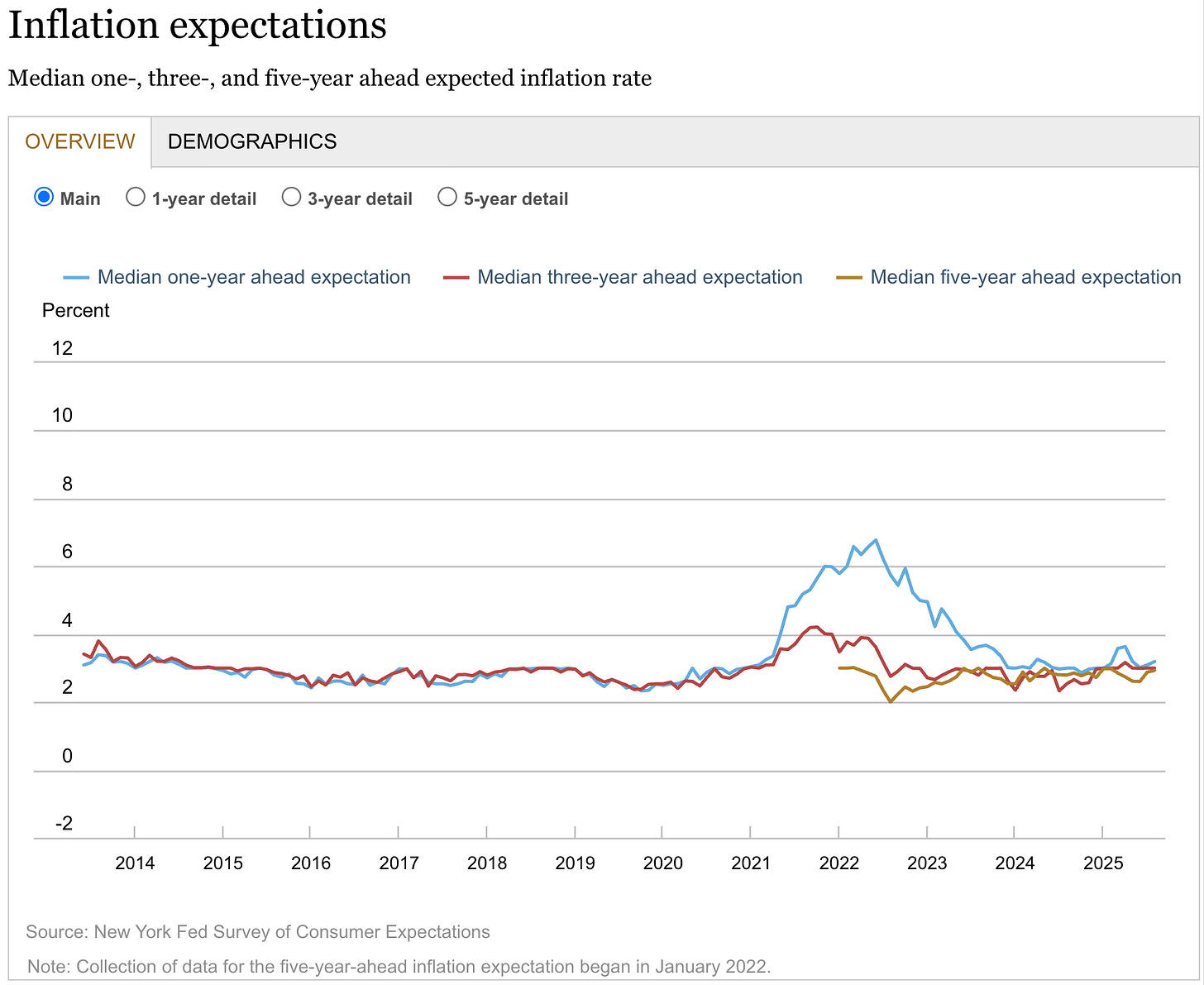
The introduction of new tariffs risks higher inflation. For more, read: 5 outstanding issues as President Trump threatens the world with tariffs 😬
👎 Job finding expectations slump. From the New York Fed’s August Survey of Consumer Expectations: “The mean perceived probability of finding a job if one’s current job was lost fell markedly by 5.8 percentage points to 44.9%, the lowest reading since the start of the series in June 2013. The decline was broad-based across age, education, and income groups, but it was most pronounced for those with at most a high school education.“
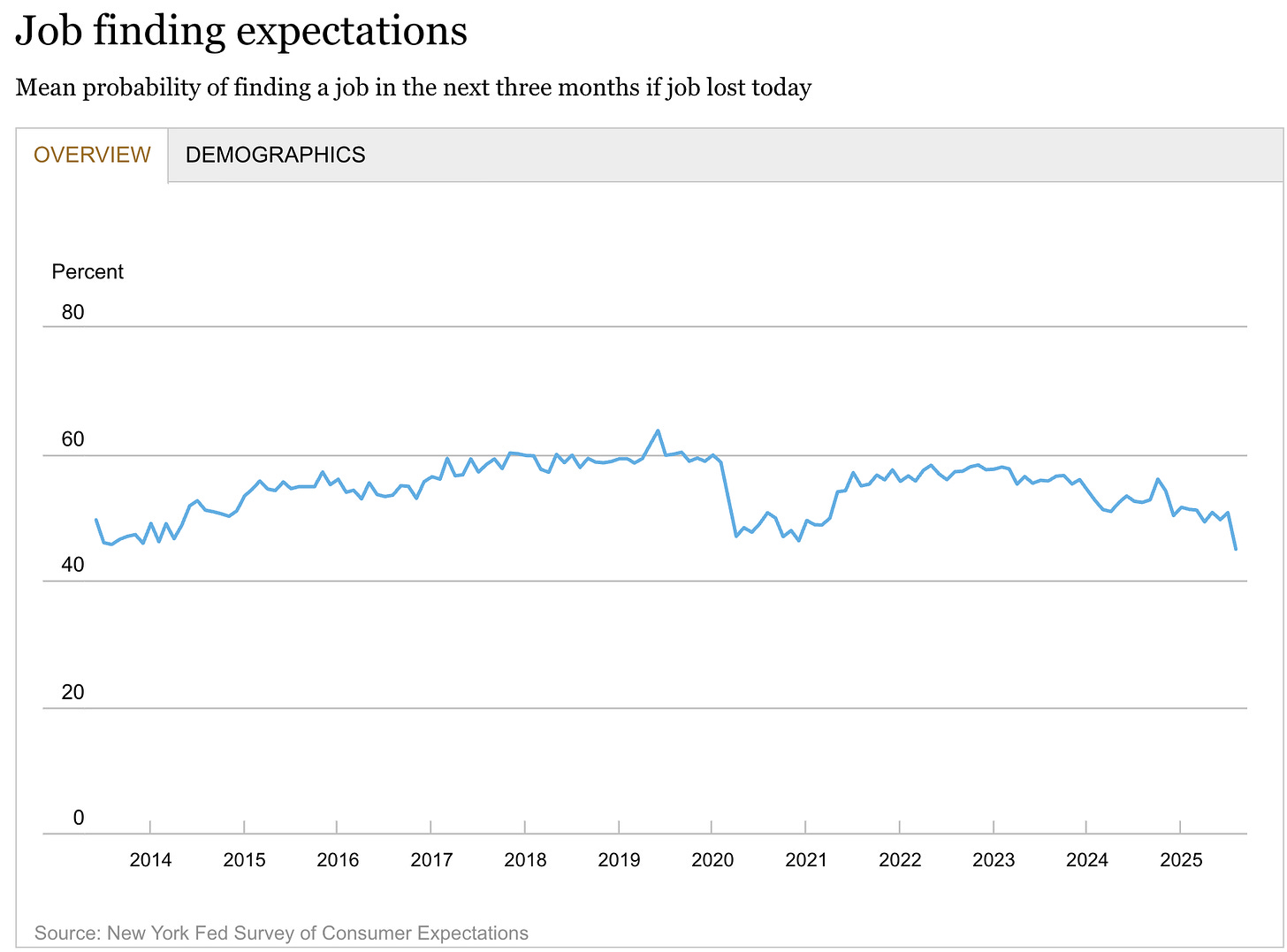
For more on the labor market, read: The economy is barely growing, and recession risk is up 😬
💼 New unemployment claims rise, total ongoing claims remain elevated. Initial claims for unemployment benefits increased to 263,000 during the week ending September 6, the highest level since October 23, 2021. This metric remains at levels historically associated with economic growth.
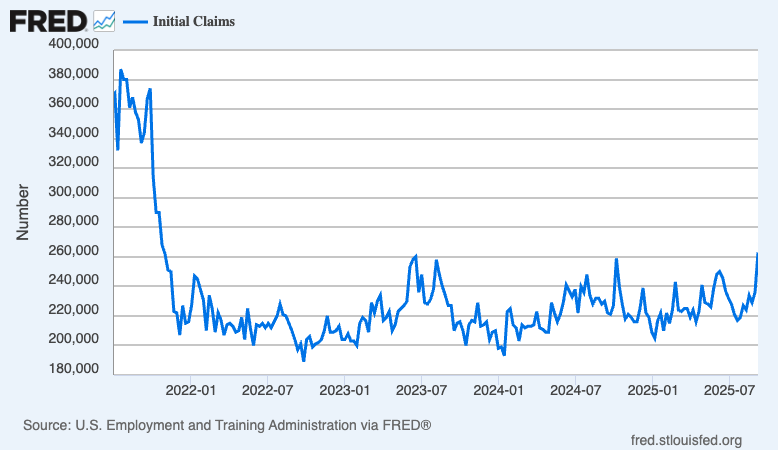
Insured unemployment, which captures those who continue to claim unemployment benefits, stood at 1.94 million during the week ending August 30. This metric is near its highest level since November 2021.
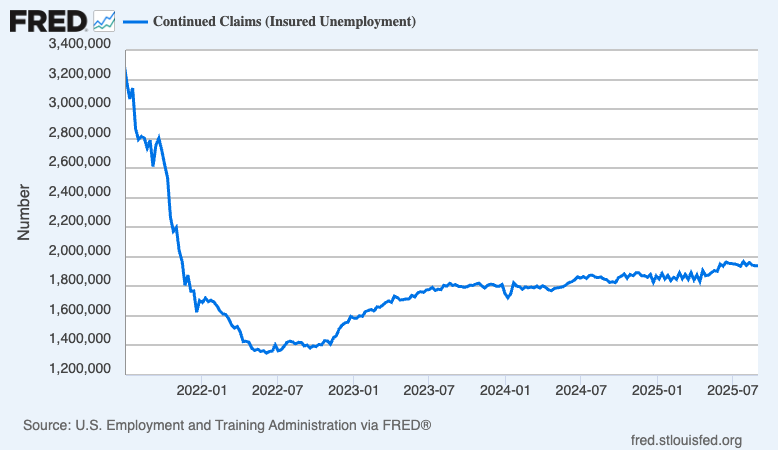
Low initial claims confirm that layoff activity remains low. Elevated continued claims confirm hiring activity is weakening. This dynamic warrants close attention, as it reflects a deteriorating labor market.
For more context, read: The hiring situation 🧩 and The labor market is cooling 💼
🤑 Wage growth is cool. According to the Atlanta Fed’s wage growth tracker, the median hourly pay in August was up 4.1% from the prior year, unchanged from the prior month.
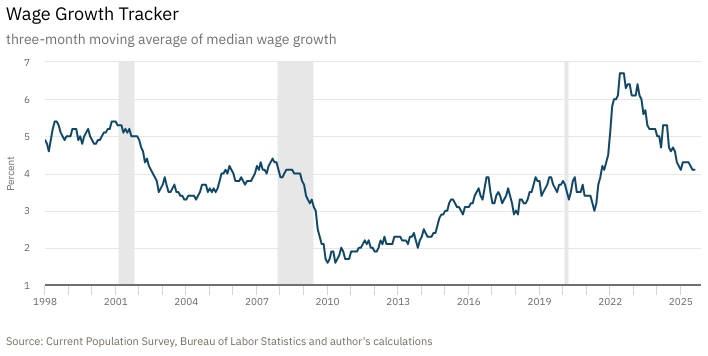
For more on why policymakers are watching wage growth, read: Revisiting the key chart to watch amid the Fed's war on inflation 📈
👎 Consumer vibes deteriorate. From the University of Michigan’s September Surveys of Consumers: “Consumers continue to note multiple vulnerabilities in the economy, with rising risks to business conditions, labor markets, and inflation. Likewise, consumers perceive risks to their pocketbooks as well; current and expected personal finances both eased about 8% this month. Trade policy remains highly salient to consumers, with about 60% of consumers providing unprompted comments about tariffs during interviews, little changed from last month.”
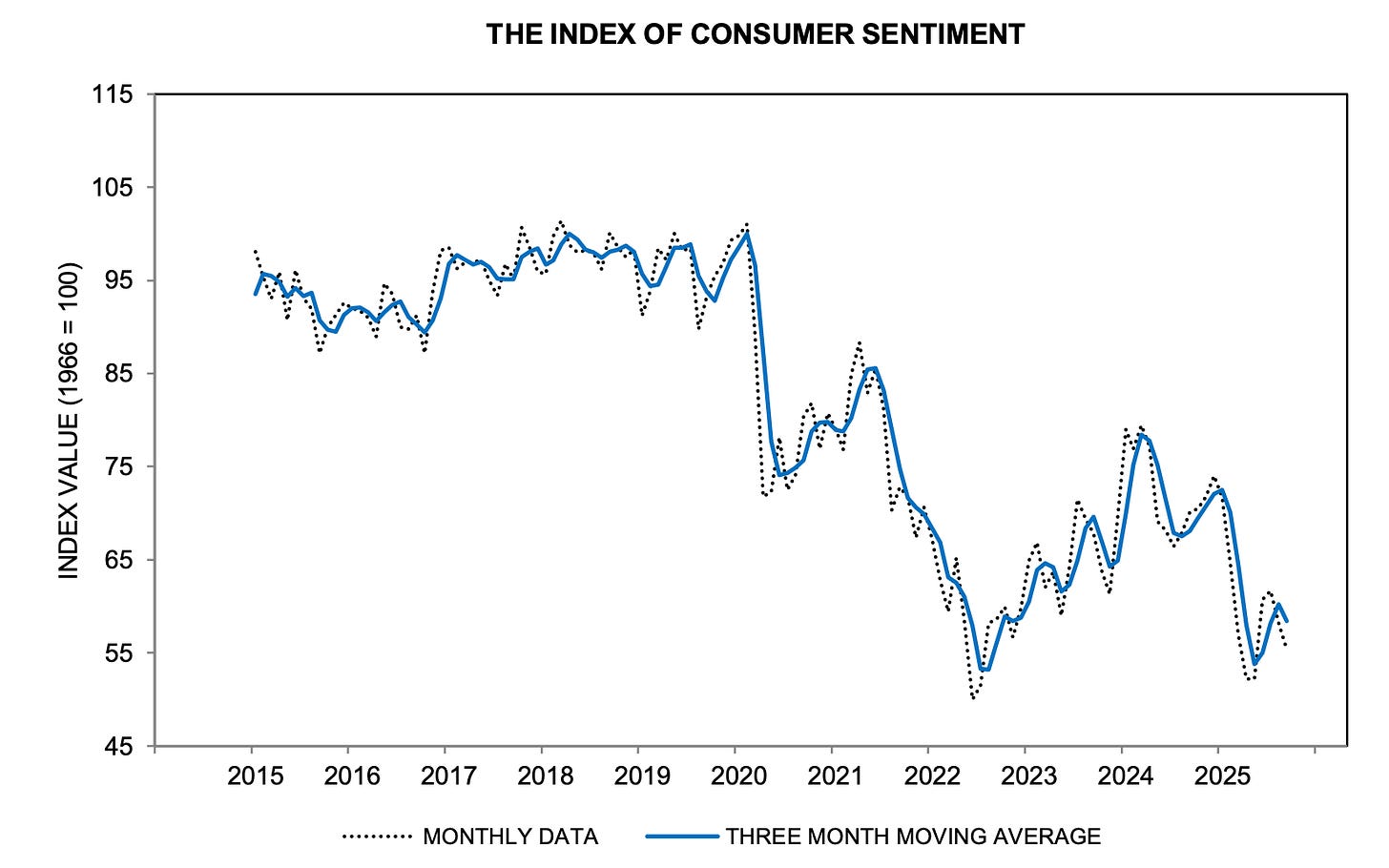
Relatively weak consumer sentiment readings appear to contradict resilient consumer spending data. For more on this contradiction, read: What consumers do > what consumers say 🙊 and We're taking that vacation whether we like it or not 🛫
💳 Card spending data is holding up. From JPMorgan: “As of 05 Sep 2025, our Chase Consumer Card spending data (unadjusted) was 2.9% above the same day last year. Based on the Chase Consumer Card data through 05 Sep 2025, our estimate of the US Census August control measure of retail sales m/m is 0.34%.”
From BofA: “Total credit and debit card spending per household increased 1.7% year-over-year (YoY) in August, after a gain of 1.8% YoY in July, according to Bank of America aggregated card data. Seasonally adjusted spending per household rose 0.4% month-over-month (MoM), the third increase in a row.“

For discussion on how sales may be inflated due to tariffs, read: A BIG economic question right now 🤔
🏠 Mortgage rates tick lower. According to Freddie Mac, the average 30-year fixed-rate mortgage stood at 6.35%, down from 6.5% last week: “The 30-year fixed-rate mortgage fell 15 basis points from last week, the largest weekly drop in the past year. Mortgage rates are headed in the right direction and homebuyers have noticed, as purchase applications reached the highest year-over-year growth rate in more than four years.”
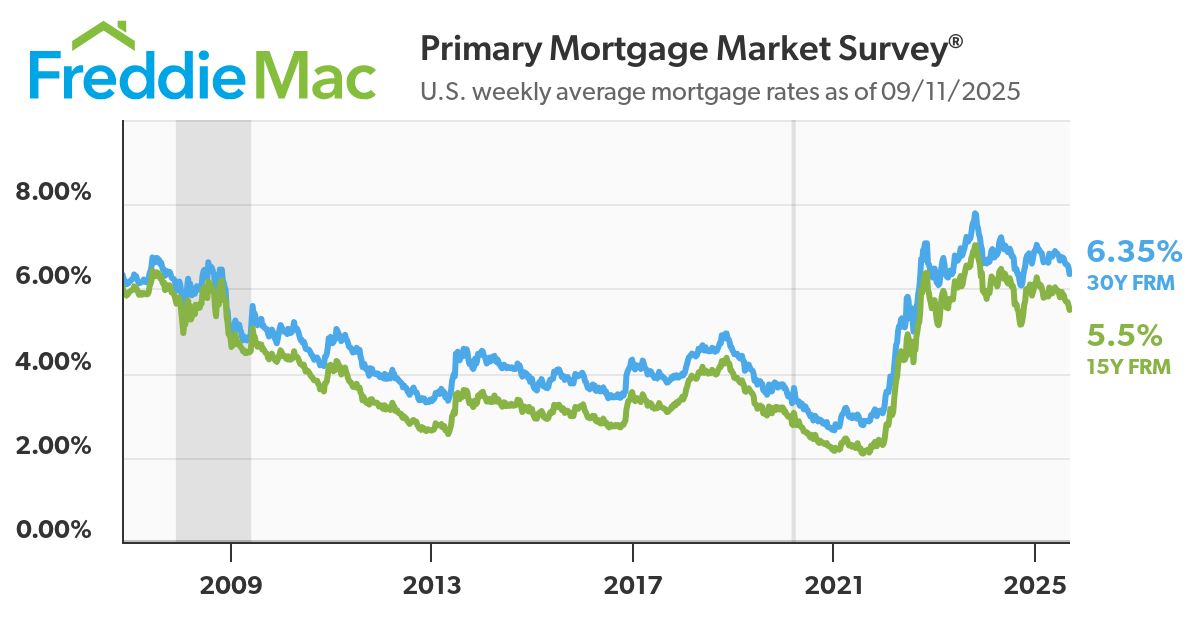
There are 147.9 million housing units in the U.S., of which 86.1 million are owner-occupied and about 39% are mortgage-free. Of those carrying mortgage debt, almost all have fixed-rate mortgages, and most of those mortgages have rates that were locked in before rates surged from 2021 lows. All of this is to say: Most homeowners are not particularly sensitive to the small weekly movements in home prices or mortgage rates.
For more on mortgages and home prices, read: Why home prices and rents are creating all sorts of confusion about inflation 😖
👍 Small business optimism ticks higher. The NFIB’s August Small Business Optimism Index rose to 100.8 in August from 100.3 in July. From the NFIB: “Optimism increased slightly in August with more owners reporting stronger sales expectations and improved earnings. While owners have cited an improvement in overall business health, labor quality remained the top issue on Main Street.”
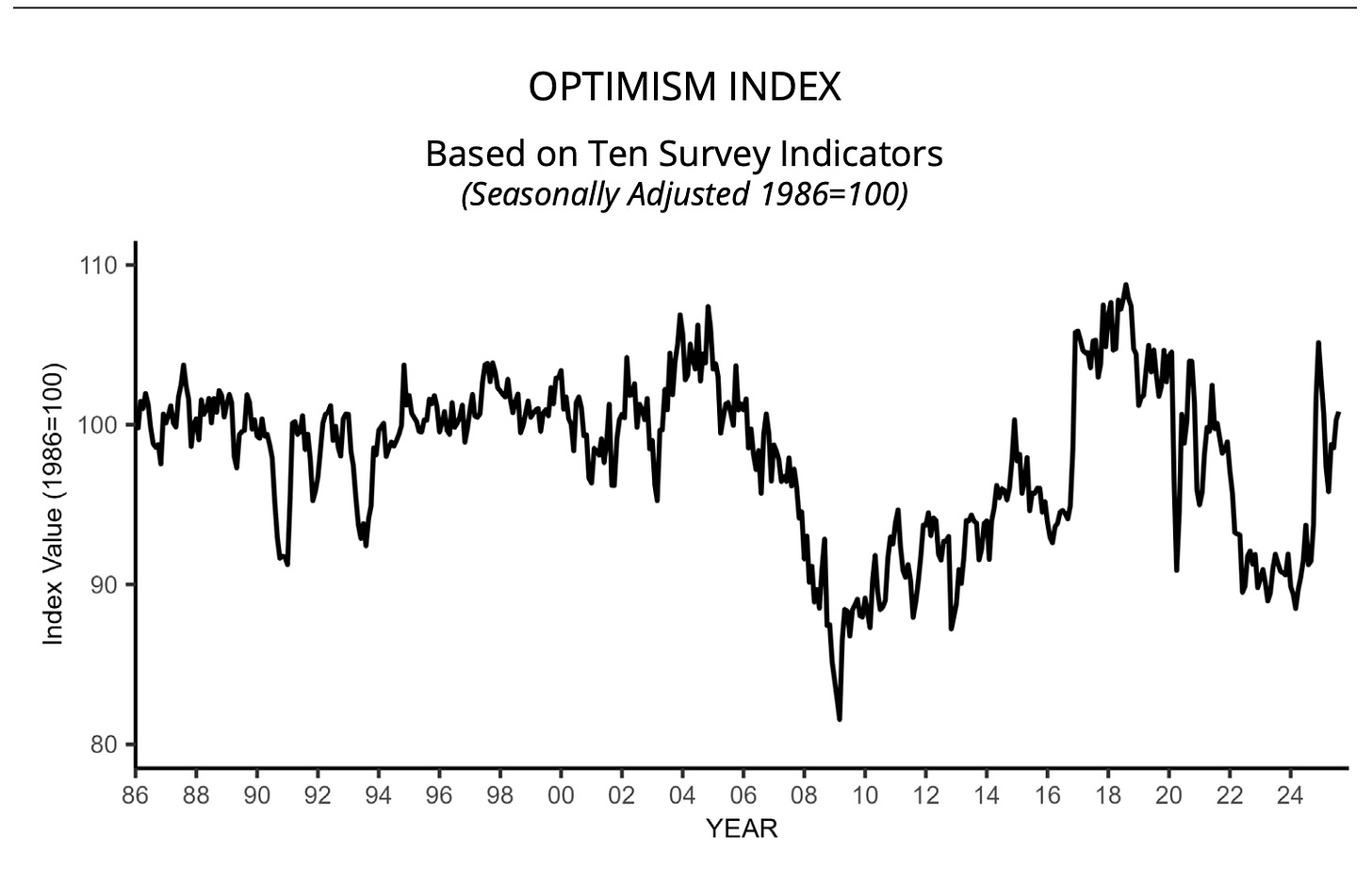
For more on the state of sentiment, read: The confusing state of the economy 📊 and Beware how your politics distort how you perceive economic realities 😵💫
🍾 The entrepreneurial spirit remains elevated. From the Census Bureau: “Total U.S. Business Applications were 473,679 in August 2025, up 0.5% from July 2025.“
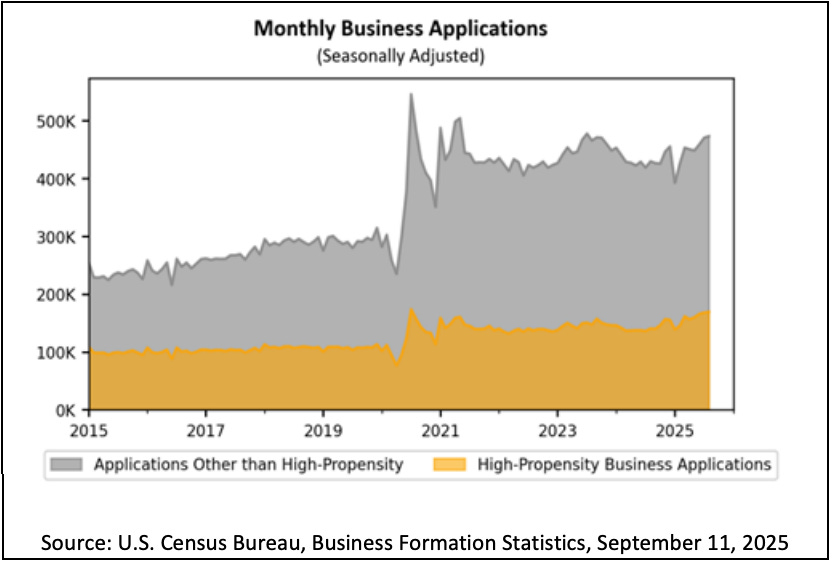
🏢 Offices remain relatively empty. From Kastle Systems: “The highest day of office occupancy last week was Wednesday at 63.2%. On Tuesday, the usual peak day, average occupancy in the 10 tracked cities was 59.7%, as workers took additional time away from the office to extend the Labor Day holiday weekend. New York City had the largest increase on Wednesday, where occupancy was up nearly 16 points from the previous week to 67.5%. The average low was on Friday at 30.8%, down three and a half points from last week.”
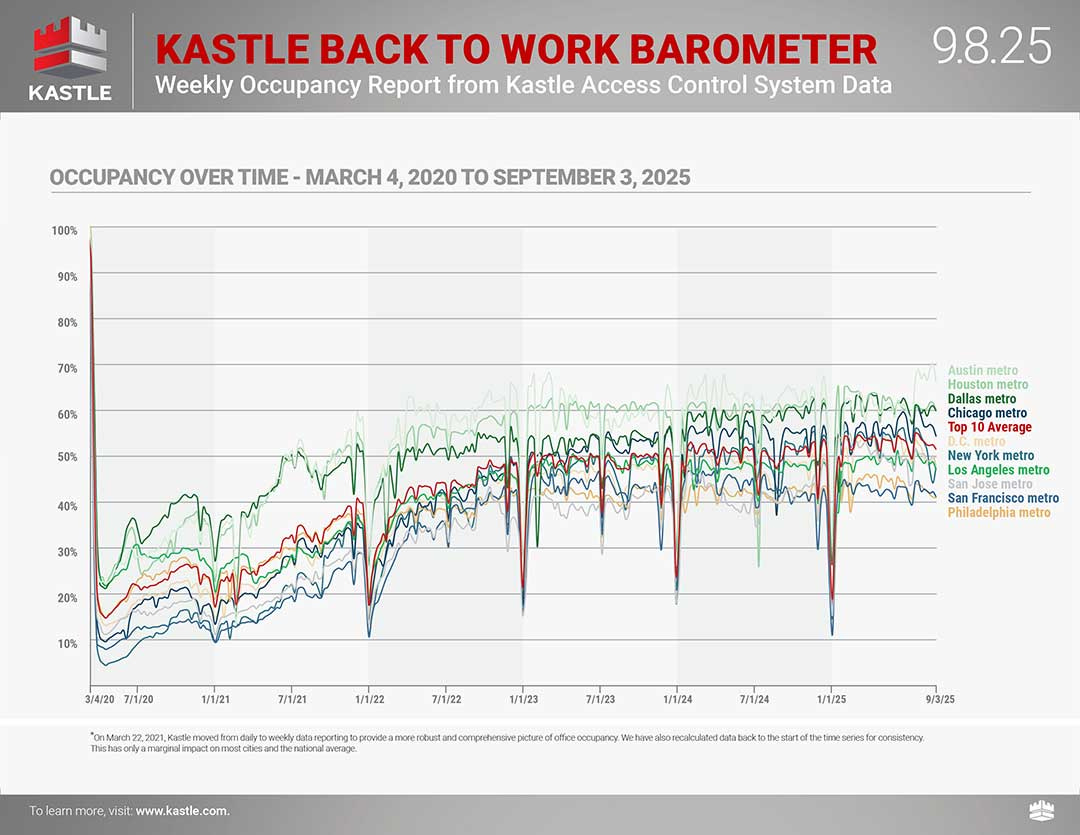
For more on office occupancy, read: This stat about offices reminds us things are far from normal 🏢
📈 Near-term GDP growth estimates are tracking positively. The Atlanta Fed’s GDPNow model sees real GDP growth rising at a 3.1% rate in Q3.

For more on GDP and the economy, read: 9 once-hot economic charts that cooled 📉 and We're at an economic tipping point ⚖️
🤷🏻♂️ Old jobs data revised lower. The BLS revised lower its jobs tally for the year through March by 911,000. Before the revision, the BLS indicated employers had created 1.8 million jobs during that period.

Two quick points: 1) This is consistent with our ongoing discussion that the economy is cooling, and 2) This does not change what we know about corporate earnings — as we’ve reiterated in our ongoing discussion about deteriorating data quality.
This is a significant development for economists, policymakers, and those who’ll use the information to advance their own interests.
It’s less significant for stock market investors because it’s backward-looking, and it doesn’t change what we already know about earnings, which have been growing and are expected to keep growing. That’s the bottom line.
Putting it all together 📋
🚨 The Trump administration’s pursuit of tariffs is disrupting global trade, with significant implications for the U.S. economy, corporate earnings, and the stock market. Until we get more clarity, here’s where things stand:
Earnings look bullish: The long-term outlook for the stock market remains favorable, bolstered by expectations for years of earnings growth. And earnings are the most important driver of stock prices.
Demand is positive: Demand for goods and services remains positive, supported by healthy consumer and business balance sheets. Job creation, although cooling, also remains positive, and the Federal Reserve — having resolved the inflation crisis — shifted its focus toward supporting the labor market.
But growth is cooling: While the economy remains healthy, growth has normalized from much hotter levels earlier in the cycle. The economy is less “coiled” these days as major tailwinds like excess job openings and core capex orders have faded. It has become harder to argue that growth is destiny.
Actions speak louder than words: We are in an odd period, given that the hard economic data decoupled from the soft sentiment-oriented data. Consumer and business sentiment has been relatively poor, even as tangible consumer and business activity continues to grow and trend at record levels. From an investor’s perspective, what matters is that the hard economic data continues to hold up.
Stocks are not the economy: There’s a case to be made that the U.S. stock market could outperform the U.S. economy in the near term, thanks largely to positive operating leverage. Since the pandemic, companies have aggressively adjusted their cost structures. This came with strategic layoffs and investment in new equipment, including hardware powered by AI. These moves are resulting in positive operating leverage, which means a modest amount of sales growth — in the cooling economy — is translating to robust earnings growth.
Mind the ever-present risks: Of course, we should not get complacent. There will always be risks to worry about, such as U.S. political uncertainty, geopolitical turmoil, energy price volatility, and cyber attacks. There are also the dreaded unknowns. Any of these risks can flare up and spark short-term volatility in the markets.
Investing is never a smooth ride: There’s also the harsh reality that economic recessions and bear markets are developments that all long-term investors should expect as they build wealth in the markets. Always keep your stock market seat belts fastened.
Think long-term: For now, there’s no reason to believe there’ll be a challenge that the economy and the markets won’t be able to overcome over time. The long game remains undefeated, and it’s a streak that long-term investors can expect to continue.
For more on how the macro story is evolving, check out the previous review of the macro crosscurrents. »
Key insights about the stock market 📈
Here’s a roundup of some of TKer’s most talked-about paid and free newsletters about the stock market. All of the headlines are hyperlinked to the archived pieces.
10 truths about the stock market 📈
The stock market can be an intimidating place: It’s real money on the line, there’s an overwhelming amount of information, and people have lost fortunes in it very quickly. But it’s also a place where thoughtful investors have long accumulated a lot of wealth. The primary difference between those two outlooks is related to misconceptions about the stock market that can lead people to make poor investment decisions.
The makeup of the S&P 500 is constantly changing 🔀
Passive investing is a concept usually associated with buying and holding a fund that tracks an index. And no passive investment strategy has attracted as much attention as buying an S&P 500 index fund. However, the S&P 500 — an index of 500 of the largest U.S. companies — is anything but a static set of 500 stocks.

The key driver of stock prices: Earnings💰
For investors, anything you can ever learn about a company matters only if it also tells you something about earnings. That’s because long-term moves in a stock can ultimately be explained by the underlying company’s earnings, expectations for earnings, and uncertainty about those expectations for earnings. Over time, the relationship between stock prices and earnings has a very tight statistical relationship.
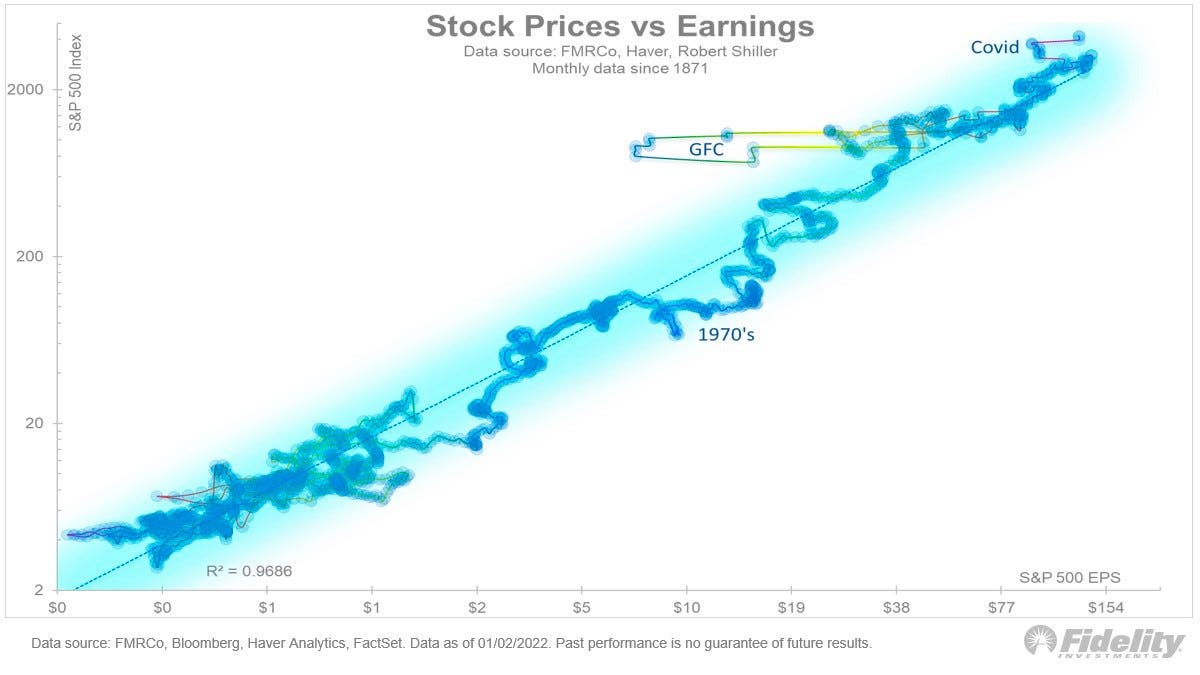
Stomach-churning stock market sell-offs are normal🎢
Investors should always be mentally prepared for some big sell-offs in the stock market. It’s part of the deal when you invest in an asset class that is sensitive to the constant flow of good and bad news. Since 1950, the S&P 500 has seen an average annual max drawdown (i.e., the biggest intra-year sell-off) of 14%.
How the stock market performed around recessions 📉📈
Every recession in history was different. And the range of stock performance around them varied greatly. There are two things worth noting. First, recessions have always been accompanied by a significant drawdown in stock prices. Second, the stock market bottomed and inflected upward long before recessions ended.

In the stock market, time pays ⏳
Since 1928, the S&P 500 generated a positive total return more than 89% of the time over all five-year periods. Those are pretty good odds. When you extend the timeframe to 20 years, you’ll see that there’s never been a period where the S&P 500 didn’t generate a positive return.

What a strong dollar means for stocks 👑
While a strong dollar may be great news for Americans vacationing abroad and U.S. businesses importing goods from overseas, it’s a headwind for multinational U.S.-based corporations doing business in non-U.S. markets.

Economy ≠ Stock Market 🤷♂️
The stock market sorta reflects the economy. But also, not really. The S&P 500 is more about the manufacture and sale of goods. U.S. GDP is more about providing services.
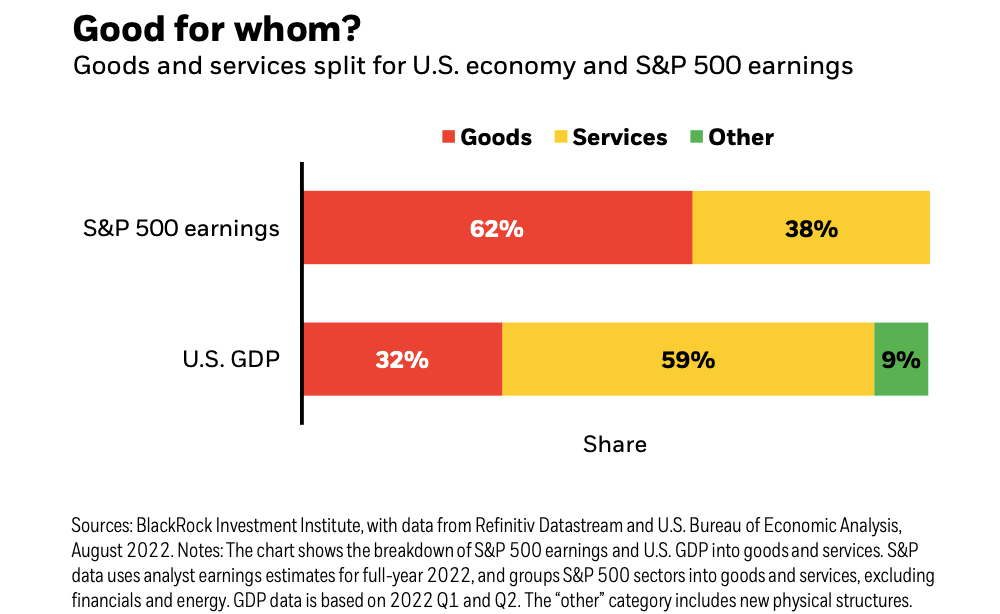
Stanley Druckenmiller's No. 1 piece of advice for novice investors 🧐
…you don't want to buy them when earnings are great, because what are they doing when their earnings are great? They go out and expand capacity. Three or four years later, there's overcapacity and they're losing money. What about when they're losing money? Well, then they’ve stopped building capacity. So three or four years later, capacity will have shrunk and their profit margins will be way up. So, you always have to sort of imagine the world the way it's going to be in 18 to 24 months as opposed to now. If you buy it now, you're buying into every single fad every single moment. Whereas if you envision the future, you're trying to imagine how that might be reflected differently in security prices.
Peter Lynch made a remarkably prescient market observation in 1994 🎯
Some event will come out of left field, and the market will go down, or the market will go up. Volatility will occur. Markets will continue to have these ups and downs. … Basic corporate profits have grown about 8% a year historically. So, corporate profits double about every nine years. The stock market ought to double about every nine years… The next 500 points, the next 600 points — I don’t know which way they’ll go… They’ll double again in eight or nine years after that. Because profits go up 8% a year, and stocks will follow. That's all there is to it.
Warren Buffett's 'fourth law of motion' 📉
Long ago, Sir Isaac Newton gave us three laws of motion, which were the work of genius. But Sir Isaac’s talents didn’t extend to investing: He lost a bundle in the South Sea Bubble, explaining later, “I can calculate the movement of the stars, but not the madness of men.” If he had not been traumatized by this loss, Sir Isaac might well have gone on to discover the Fourth Law of Motion: For investors as a whole, returns decrease as motion increases.
Most pros can’t beat the market 🥊
According to S&P Dow Jones Indices (SPDJI), 65% of U.S. large-cap equity fund managers underperformed the S&P 500 in 2024. As you stretch the time horizon, the numbers get even more dismal. Over a three-year period, 85% underperformed. Over a 10-year period, 90% underperformed. And over a 20-year period, 92% underperformed. This 2023 performance follows 14 consecutive years in which the majority of fund managers in this category have lagged the index.

Proof that 'past performance is no guarantee of future results' 📊
Even if you are a fund manager who generated industry-leading returns in one year, history says it’s an almost insurmountable task to stay on top consistently in subsequent years. According to S&P Dow Jones Indices, just 4.21% of all U.S. equity funds in the top half of performance during the first year were able to remain in the top during the four subsequent years. Only 2.42% of U.S. large-cap funds remained in the top half
SPDJI’s report also considered fund performance relative to their benchmarks over the past three years. Of 738 U.S. large-cap equity funds tracked by SPDJI, 50.68% beat the S&P 500 in 2022. Just 5.08% beat the S&P in the two years ending 2023. And only 2.14% of the funds beat the index over the three years ending in 2024.

The odds are stacked against stock pickers 🎲
Picking stocks in an attempt to beat market averages is an incredibly challenging and sometimes money-losing effort. Most professional stock pickers aren’t able to do this consistently. One of the reasons for this is that most stocks don’t deliver above-average returns. According to S&P Dow Jones Indices, only 24% of the stocks in the S&P 500 outperformed the average stock’s return from 2000 to 2022. Over this period, the average return on an S&P 500 stock was 390%, while the median stock rose by just 93%.






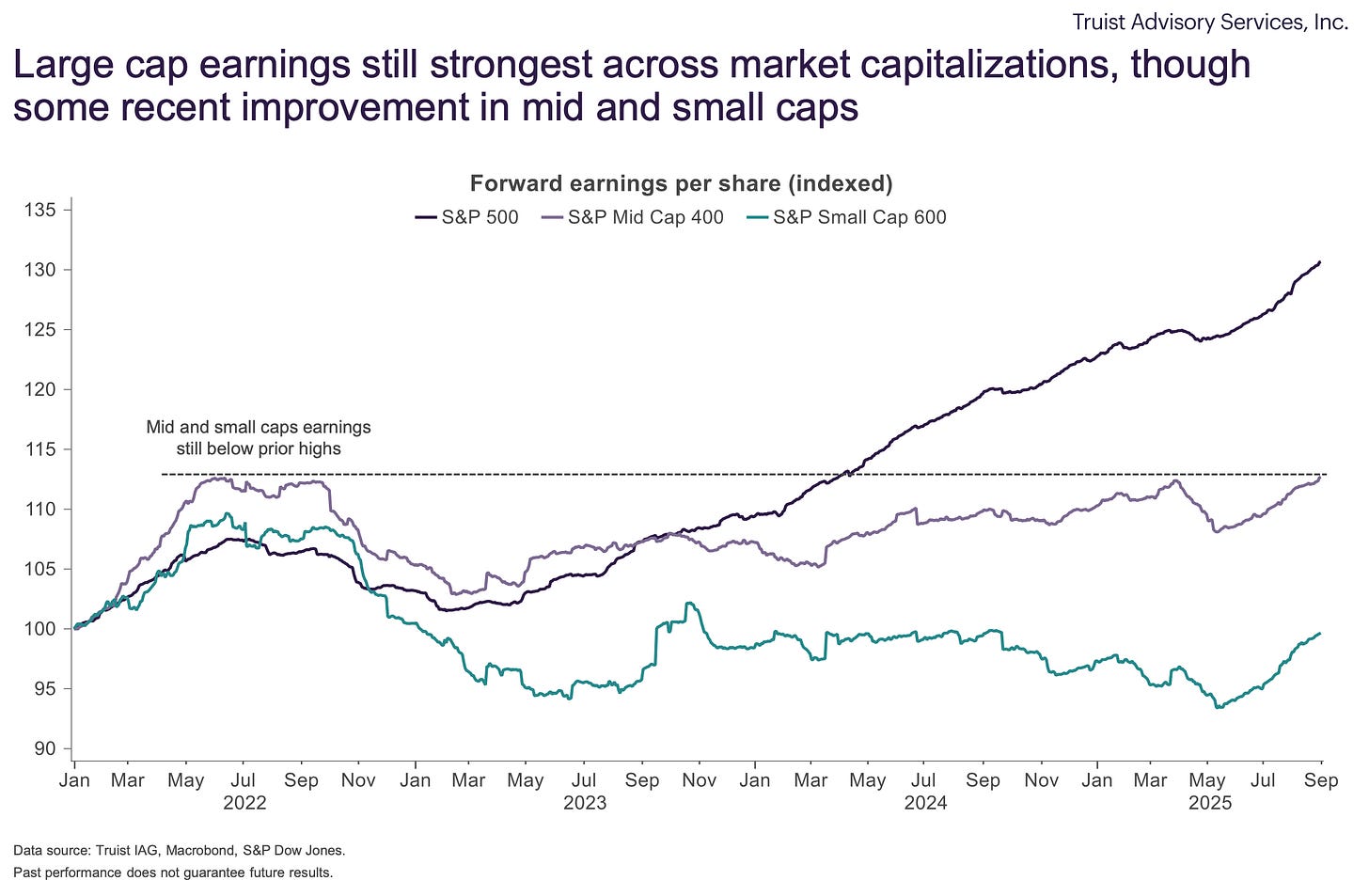





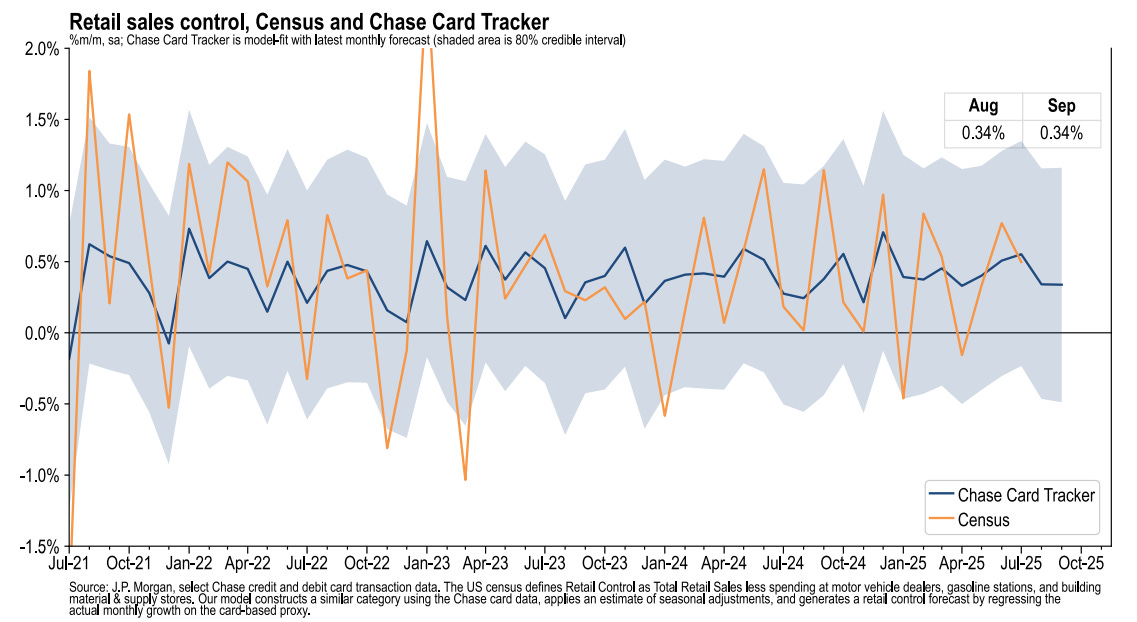

I think we'll continue to see a further decoupling of consumer sentiment and the strength of the economy as wealth continues to become further concentrated in the top 10% of US households.
It’s an interesting moment for “Big rallies are followed by further gains” in particular. I was recently laid off and the job market is extremely challenging, so I’ve been wondering if I should take some profits before the inconsistency and uncertainty in our national leadership causes more economic pain that impacts stock prices. Valuable information as always.